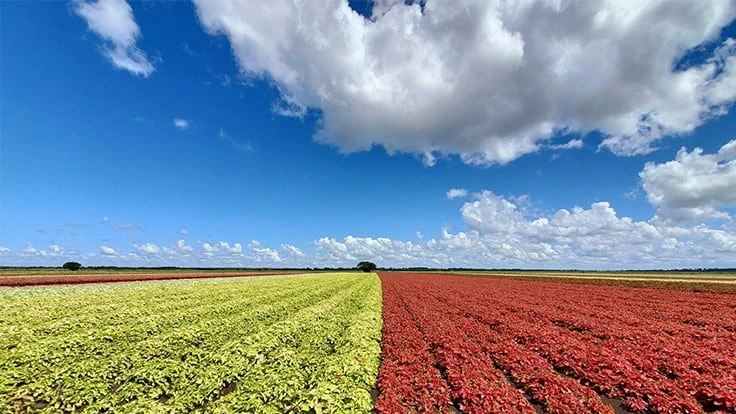
Photo courtesy of BASF
At Bates Sons & Daughters in Lake Placid, Florida, rows of pink, white, red and green caladiums stretch for 100 acres. The operation is one of eight caladium growers in the world — all of them are based in and around Lake Placid, which has acidic “muck” soils that are conducive to growing the rainforest-derived crop.
A different perspective makes Bates Sons & Daughters stand out from other operations in The Caladium Capital of the World. “We're the only completely female-run caladium farm in the industry,” says co-owner Terri Bates.
Founded by Bates’ grandfather, Emmett Bates, after he returned from World War II, Bates and Sons continued into the second generation with Emmett’s two sons, Don and Fred. Under the expanded name, it is now run by two of Don’s four daughters: Bates and her sister Sheri. A third daughter, Heidi, left the farm for two decades, but recently rejoined as office manager.
Every year, the operation offers 40 to 50 varieties of caladium. In 2019 it grew 41, says Bates, who has a horticulture degree from the University of Florida. “If there are any ones that are not producing well, I'll take them out of production and go with the new ones,” she says.
Out of all the colors, white varieties are the first to show disease symptoms, and about 20 years ago, Bates noticed Pythium root rot on her whites.
"It's a root rot disease,” Bates says. “You're growing a root structure and you're growing in [a] very hot, humid, moist environment. It's just a perfect playground for Pythium — and it's a water mold.”
Something had to be done, so Bates started using pyraclostrobin and boscalid to prevent her caladiums from getting stressed. After making applications, the plants’ colors began to pop and their vigor improved. In some cases, they grew taller than they previously did.
“The increase in my white varieties was something like 60 to 75% more the first year, which is huge, in size and in numbers,” Bates says. “My market are the bigger tubers … My goal is to grow what they call ‘#1s’ and ‘jumbos.’ But the increase in the number of jumbos I got that first year was incredible.”
However, nature abhors a vacuum, and Fusarium was able to move into some of Bates’ caladium crop. “It's kind of like a synergy,” she says. Although Bates says she knows the disease was from the field, the symptoms didn’t appear until three to four weeks after harvest.
“We hand-count and hand-grade everything, so if I have a problem with Fusarium, it's just my loss on my end,” she says. “I'm not shipping that out.” On the off chance that a customer receives a diseased caladium, she says, they can have it replaced by Bates Sons & Daughters.
Last year, Bates tried triticonazole for the first time on Fusarium. “All of a sudden, I went from a certain amount of disease pressure in some varieties to half or a quarter of that,” she says. She is hopeful that her 2019 harvest will be disease-free.
Some product applications have had unforeseen benefits. Using pyraclostrobin and boscalid for Pythium, for instance, caused the vigor of her caladiums to become so high that the tractor wheel rows are covered over and some short varieties have become much taller, Bates says.
“We don't have as many weeds because of that, either, because [if] the crop's covered over, the weeds can't grow,” she says. “So they're taller, they're more colorful, they're covered over, there are no significant weed issues going on. They just look better."
Latest from Greenhouse Management
- Meet the Next Gen: Gabriella Blair, Star Roses and Plants
- Leading Women of Horticulture: Katie Dubow, Garden Media Group, and Aubry Field, Lizzy Blossom
- Showing up at your horticulture business as your whole self
- Leading women of Greenhouse Management
- USDA fires experts on invasive pests, including Asian citrus psyllid, chilli thrips
- Farwest Show calls for 2025 New Varieties Showcase entries
- Leading Women of Horticulture: Arden Pontasch, North Creek Nurseries
- Leading Women of Horticulture: Emily Showalter, Willoway Nurseries








